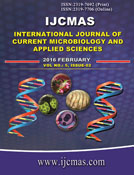


 National Academy of Agricultural Sciences (NAAS)
National Academy of Agricultural Sciences (NAAS)

|
PRINT ISSN : 2319-7692
Online ISSN : 2319-7706 Issues : 12 per year Publisher : Excellent Publishers Email : editorijcmas@gmail.com / submit@ijcmas.com Editor-in-chief: Dr.M.Prakash Index Copernicus ICV 2018: 95.39 NAAS RATING 2020: 5.38 |
Nosema is a microsporidian parasite of honey bees causing high losses in apiculture and consequently in agriculture. A study was carried out to determine the prevalence of Nosema spp in some apiaries in Nasarawa and Plateau States, Nigeria. A total of 71 samples from a cohort of 20 colonies kept in four apiaries in parts of Nasarawa and Plateau states were collected and examined for the prevalence of Nosema infection from June to September, November and December 2013, then January and March 2014. A non-quantitative microscopy method was used to examine for Nosema spp in the honey bees. The data were subjected to Chi-square analysis. The highest prevalence (55 %) was observed in Berg apiaries in Karu L.G.A. of Nasarawa state. There is no significant difference (P > 0.05) in the infection of bees between the apiaries, as well as in relation within the rainy or dry season. The infection was generally higher in the rainy season than in the dry season, with the highest prevalence of 71.4 % during the months of August. However, there is a significant difference (P < 0.05) in nosemosis infection between the seasons. The significance of the research is discussed.
 |
 |
 |
 |
 |